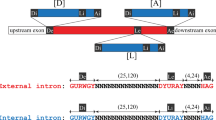Summary
Some pet- (or mit-) mutations impeding the splicing of one or several intron(s) of the yeast mitochondrial pre-mRNA(s) are suppressed in vivo by the DNA deletion of these introns. We have genetically demonstrated that introns aI1 and/or aI2 of the cytochrome c oxidase subunit 1 gene are necessary for this deletion process. The facts that adjacent introns are simultaneously deleted and that, in the pet- (or mit-) mutants which easily revert by intron deletion, the splicing of the introns they affect is only partially blocked, suggest that the intron encoded proteins aI1 and/or aI2 could intervene by means of their putative reverse transcriptase activity.
Similar content being viewed by others
References
Baltimore D (1985) Retroviruses and retrotransposons: the role of reverse transcription in shaping the eukaryotic genome. Cell 40:481–482
Bonitz S, Coruzzi G, Thalenfeld B, Tzagoloff A, Macino G (1980) Assembly of the mitochondrial membrane system. Structure and nucleotide sequence of the gene coding for subunit 1 of yeast cytochrome oxidase. J Biol Chem 255:11927–11941
Colleaux L, d'Auriol L, Betermier M, Cottarel G, Jacquier A, Galibert F, Dujon B (1986) Universal code equivalent of a yeast mitochondrial intron reading frame is expressed in E. coli as a specific double strand endonuclease. Cell 44:521–533
Conde J, Fink G (1976) A mutant of Saccharomyces cerevisiae defective for nuclear fusion. Proc Natl Acad Sci USA 73:3651–3655
Davis R, Thomas M, Cameron J, St John T, Scherer S, Padgett R (1980) Rapid DNA isolations for enzymatic and hybridization analysis. Methods Enzymol 65:404–411
Donahue TF, Daves R, Lucchini G, Fink G (1983) A short nucleotide sequence required for regulation of HIS4 by the general control system of yeast. Cell 32:89–98
Fawcett DH, Lister CK, Kellett E, Finnegan D (1986) Transposable elements controlling I-R hybrid dysgenesis in D. melanogaster are similar to mammalian LINEs. Cell 47:1007–1015
Fink G (1987) Pseudogenes in yeast? Cell 49:5–6
Gargouri A, Lazowska J, Slonimski P (1983) DNA-splicing of introns in the gene: a general way of reverting intron mutations. In: Schweyen R, Wolf K, Kaudewitz F (eds) Mitochondria 1983. Nucleo-mitochondrial interactions. W. de Gruyter, Berlin, pp 259–268
Grivell L (1984) Restriction and genetic maps of yeast mitochondria DNA. In: O'Brien S (ed) Genetic Maps 1984. Cold Spring Harbor Laboratory Press, New York, pp 234–247
Hill J, McGraw P, Tzagoloff A (1985) A mutation in yeast mitochondrial DNA results in a precise excision of the terminal intron of the cytochrome b gene. J Biol Chem 260:3235–3238
Jacq C, Pajot P, Lazowska J, Dujardin G, Claisse M, Groudinsky O, de la Salle H, Grandchamp M, Labouesse M, Groudinsky A, Guiard B, Spyridakis A, Dreyfus M, Slonimski P (1982) Role of introns in the yeast cytochrome b gene: cis- and transacting signals, intron manipulation, expression and intergenic communications. In: Slonimski P, Borst P, Attardi G (eds) Mitochondrial Genes. Cold Spring Harbor Laboratory Press, New York, pp 155–183
Lancashire W, Mattoon J (1979) Cytoduction: a tool for mitochondrial genetic studies in yeast. Utilization of the nuclear-fusion mutation kar1-1 for transfer of drugR and mit- genomes in Saccharomyces cerevisiae. Mol Gen Genet 170:333–344
Michel F, Lang F (1985) Mitochondrial class II introns encode proteins related to the reverse transcriptases of retroviruses. Nature 316:641–643
Perea J, Jacq C (1985) Role of the 5′ hairpin structure in the splicing accuracy of the fourth intron of the yeast cob-box gene. EMBO J 4:3281–3288
Picard-Bennoun M (1985) Introns, protein synthesis and aging. FEBS Lett 184:1–5
Rothstein R (1983) One-step gene disruption in yeast. Methods Enzymol 101:202–211
Séraphin B, Boulet A, Simon M, Faye G (1987a) Construction of a yeast strain devoid of mitochondrial introns and its use to screen genes involved in mitochondrial splicing. Proc Natl Acad Sci USA 84:6810–6814
Séraphin B, Simon M, Faye G (1987b) The mitochondrial reading frame RF3 is a functional gene in Saccharomyces uvarum. J Biol Chem 262:10146–10153
Séraphin B, Simon M, Faye G (1988) MSS18, a yeast nuclear gene involved in the splicing of intron aI5β of the mitochondrial cox1 transcript. EMBO J 7:1455–1464
Sherman F, Fink G, Hicks J (1983) Methods in yeast Genetics. Cold Spring Harbor Laboratory Press, Cold Spring Harbor, New-York
Simon M, Faye G (1984) Steps in processing of the mitochondrial cytochrome oxidase subunit I pre-mRNA affected by a nuclear mutation in yeast. Proc Natl Acad Sci USA 81:8–12
Tzagoloff A, Myers A (1986) Genetics of mitochondrial biogenesis. Annu Rev Biochem 55:249–285
Weiner A, Deininger P, Efstratiadis A (1986) Nonviral retroposons: genes, pseudogenes and transposable elements generated by the reverse flow of genetic information. Annu Rev Biochem 55:631–661
Author information
Authors and Affiliations
Additional information
Communicated by P. Tiollais
Rights and permissions
About this article
Cite this article
Levra-Juillet, E., Boulet, A., Séraphin, B. et al. Mitochondrial introns aI1 and/or aI2 are needed for the in vivo deletion of intervening sequences. Mol Gen Genet 217, 168–171 (1989). https://doi.org/10.1007/BF00330957
Received:
Issue Date:
DOI: https://doi.org/10.1007/BF00330957




